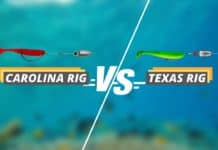Do you want to experience the joy of fishing without investing in a boat or renting a charter? Surfcasting is the answer because you can fish right on the beach!
In this article, we’ll take you into the exciting world of surfcasting, including the equipment you need and even casting tips.
What Is Surfcasting?
Surfcasting is a fishing technique that involves casting artificial or natural bait from the shoreline or where the waves break. It is called surfcasting because the angler is casting into the surf/waves of the body of water.
Expert Insight: While the waves and tide can sometimes make it more challenging to reel fish in, skilled and seasoned or experienced anglers use it to their advantage.
What is Needed for Surfcasting?
The gear you will use in surfcasting is similar to standard freshwater or saltwater fishing – you will need a fishing line, reel, rod, and bait.
Fishing Line
The line you choose for surf-casting will mainly depend on the fish you are pursuing.
More seasoned surfcasting anglers use 30-50lb braided lines to catch larger fish. Monofilament or braid lines with a 15–20 lb test are fine for small fish and calm waters.
Expert Tip: You should change your lines periodically to reduce the possibility of an unexpected snapping.
There are three types of fishing lines – monofilament, braided, and fluorocarbon. Each has unique properties and can be better than the others, depending on the fishing situation.
- Monofilament: These lines are easy to tie and reasonably priced. Unfortunately, it is more prone to breaking since it can absorb moisture. These lines will also lose some of their strength over time. In a strong tide, these lines may not hold up.
- Braided: Braided lines are often the choice of many surf-casters because of their resistance to abrasion and exceptional casting ability. However, it is expensive and challenging to tie.
- Fluorocarbon: These fishing lines do not absorb water and have a slightly better abrasion resistance than monofilaments. The difference is that the fluorocarbon line sinks and is stiffer.
Baits and Lure
You can also use fresh baits like ragworms, eels, and even mussels. Sand Fleas are another excellent option. Plus, you can catch these crustaceans yourself!
A bucktail jig is also an outstanding option for fishing off the beach. We also recommend paddle tails and twitch baits.
Surf Casting Rods
Fishing rods for surfing are longer, so you can cast farther beyond the waves breaking close to the shoreline.
The ideal rod length for fishing rods will depend on how calm the waters are and the type of fish. But, in general, you should have at least a 9–12 foot rod. Anything under 9 will only be suitable for calm waters.
You will also need to have the right action rod. A fast-action rod is best for surf casting.
Fast action is when only the top part of the rod bends when exposed to pressure. This will give you more control and better sensitivity when your bait gets touched.
As for rod power, surfcasting fishing rods should be medium-heavy for fighting strength.
Surf Casting Reels
Spinning, baitcasting, and spincast reels are all suitable for surf fishing. What you should be aware of is the size of the reel, as you will be battling not only the fish but also water drag when you are retrieving the line.
If you are targetting medium-sized fish like snapper or cod, you should opt for a 4000-6500 (40-65) reel size. Get a 7000-9000 (70-90+) reel for tuna or kingfish fishing.
Expert tip: When choosing reel size, bigger is always better. Not only can you catch small, medium, or large fish species, but you’ll also have a larger spool capacity.
When fishing off the shore, you’ll want to have 25-300 yards of line in your reel. This can allow you to cast beyond the breakers and find good spots where fish are swimming.
Sinkers
Seasoned surf casters add sinkers or weights to the fishing line, so the bait stays at a specific depth. A 2 to 4 oz. pyramid or sputnik sinker works best for surf-fishing. You can go heavier if the waters are rough or when the waves are bigger.
Hooks
Hooks for surf fishing also depend on what type of fish you are targetting. Circle hooks with 2/0 size are exceptional for all-around surf casting and reeling small fish like whiting and pompano. This hook type and size will also work with bluefish.
For larger targets like tarpons and sharks, swap your circle hook with a 5/0 J hook.
What Rigs Are Best for Surfcasting?
You’ve got your hooks, sinkers, reels, baits, and a rod, but what rig is best for surf-fishing? You have four options, and they are:
Carolina Rigs

A Carolina rig or C-rig is not only for freshwater bass fishing; it is also suitable for surf fishing, all thanks to its simple yet effective bait presentation. As a matter of fact, you will only need:
- Sliding egg weight
- Bead
- Swivel
- Leader
- Hook
This rig is better in open water because it can get caught on rocks and other debris.
Drop Shot

Like the C-rig, the drop shot rig is versatile. You can use it either with stationary or retrieving baits.
This rig is suitable if you want to present baits just a little above the water bottom or you’re targetting fish that mostly stays within the middle to the lower section of the water column.
Fish Finder Rig

At first glance, a fish finder rig may seem identical to the C-rig, but there are a few key differences. Instead of using a sliding egg weight, you will swap it with a 2-3oz pyramid weight.
A fish finder rig also uses a sliding sinker to secure itself to the bottom while allowing the bait to move freely.
Expert Tip: When fishing in a stronger current, you can spread out more lines and let your bait find the fish for you.
Pompano Rig

The pompano rig is more complex than the three previously mentioned rigs.
Also called the chicken or spot rig, the pompano rig consists of two or more hooks, beads, snell floats, a barrel swivel, and a pyramid sinker. This bait presentation has two benefits:
- Increase your chances of getting a bite
- Great for vertical jigging, especially when fishing from jetties or piers
Unfortunately, using a pompano rig also means you will need to quickly set the hook up or risk the chances of a fish dropping the bait.
Where is the Best Place to Surfcast?
The best place to surf and cast is away from the crowds. This is because any movement or sound in the water can spook fish. You’ll want to go to sandy beaches, shorelines, jetties, inlets, sandbars, and rocky points.
When is the Best Time to Surfcast?
The best time to surf cast is both at sunrise and sunset. Most fish have nocturnal feeding habits and, as such, will be more likely to take the bait when it is dark out. Beaches will also be calmer since most people have not arrived yet or have already gone home at these times.
What Fish Can I Catch When Surfcasting?
One of the best things about surf-fishing is that you never know what you will catch. Smaller fish commonly hang out by the shore, but sometimes you can snag some large ones. Of course, it depends on what area of the world you are fishing in. Here is a list of some fish you are more likely to catch:
- Striped Bass
- Flounder
- Halibut
- Bonito
- Pompano
- Stripers
- Rockfish
- Mackarel
How to Surfcast?
Even though the goal of catching a fish from the shore may appear simpler than boat fishing, the process can be complex. Thankfully, surfcasting is incredibly rewarding when done successfully.
To surf cast:
- You will want to be on the beach, a few feet away from the water. It is ideal to surf fish around high tide and during the early morning or late evening.
- Once your rod and rig are set up, you can use one of the casting techniques discussed below (overhead, off-the-ground, or pendulum) to cast into the water.
Expert Tip: You can cast out as close as 15 feet or over hundreds of feet. Smaller fish are frequently found closer to shore.
Your job is not done once you cast.
- You should check your bait every 10 minutes to ensure it is still on the hook.
- Monitor your rod if it bends drastically. If it does, it is a sign that you have a fish on the line and need to reel it in!
Casting Techniques and Tips
Proper casting is essential to an angler’s success on the water. In surfcasting, you have three options – overhead, off-the-ground, and pendulum.
Keep in mind that any new caster will struggle initially, but with some practice, you will get the hang of it.
Overhead Cast
The overhead cast is a bit easier to control than other casting techniques. Plus, your cast should go exactly where you point the rod.
- Start with the top of your rod on the ground with about 15 ft of line out. Have your thumb on the spool.
- Raise the pole to about a 10 o’clock position.
- From that position, quickly position your forearm to 2 o’clock.
- After the line straightens out, quickly move your arm back forward to the 11 o’clock position. As the lure is cast, the thumb will come off the spool and then be put back down as the lure slows down.
Off-the-ground cast
Commonly known as OTG online, an off-the-ground cast is a relatively simple cast to learn for those looking to increase their casting distances.
OTG and pendulum casts can be dangerous if you are inexperienced and on a crowded beach, so proceed with caution while learning these techniques.
- Have your weight on your back foot and left elbow pointing at the target (where you cast).
- Turn your head to look at a target and begin to send your weight forward.
- Throw the right hand powerfully forward while pulling in with the left hand.
- Follow through the cast with the right hand and fish!
Pendulum Cast
Some consider pendulum casting the best way to fish from shallow beaches because of the incredible distance it reaches.
To pendulum cast, you’ll need a rod that is not too stiff and long but not so long that you cannot control it.
- Keep one hand on the butt of the fishing rod and the other close to or on your chest.
- Stand with your back at a 45-degree angle to the water. The fishing bait will be quite close to the ground.
- Swing the lead. Ensure that the rod and the lead are swinging together instead of apart.
- Use your whole body to give more energy and momentum to your cast while attempting to make use of the whipping motion of the rod.
- Put extra force behind your bait or lure when you let go of the fishing line. With your other hand, which is holding the fishing rod close to your butt, bring it down and draw it back firmly while your leading hand —also known as the power hand — extends.
Surf-fishing, Is It for You?
Surf-fishing is straightforward in theory, but mastering water reading, tide timing, and gear selection can transform a boring beach day into an exciting fishing trip.
The great thing about surfcasting is that the more you do it, the better you get, and consequently, the more fun it is.
Table of Contents



